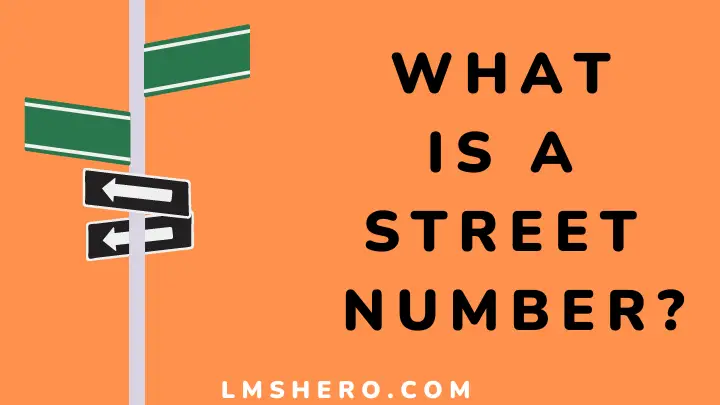A street number might seem one of the more boring pieces of information, but did you know they have a pretty exciting history?
Numbers have always played an important role in our lives, whether we consciously acknowledge it or not.
They help us to organize the world around us, helping us to understand situations that otherwise might seem chaotic and complicated. A street number is no different.
They are an important part of city planning and urban development that has evolved to serve everyone from residents to delivery drivers.
In this article, you’ll learn about the meaning of street numbers, where they came from, and how they impact your daily life, so keep reading.
What is a street number?
A street number is a numerical identifier assigned to a property or building in an urban area.
It acts as a map and reference point for the location of that property or building. It allows residents, business owners, emergency responders, and others to find it quickly and efficiently.
The system of assigning numbers to streets is known as “Addressing”. Street numbering systems are used in most countries around the world and can be subdivided for administrative purposes into zones (such as residential districts) or blocks.
Under the house numbering system, houses are numbered so that odd numbers go on the left side of the street and even numbers are on the right side.
In addition, streets are generally numbered even on the north and west sides and odd on the south and east sides.
What is the purpose of a street number?
A street number is one of the most important features of modern cities. They’re a visual representation of our place in the world and help us easily find our way.
Street numbers help to keep track of buildings and other structures on a particular street.
The purpose of a street number is to make it easier for emergency responders and public safety officials to find the location of houses, businesses, and other structures on a particular street.
In some cities, street numbers were originally used as tax identification numbers. Sometimes it’s just a way of differentiating between two roads or dividing one road into two sections.
Street numbers also serve as a means for addressing mail and packages. A mailman can easily figure out where to deliver your mail by checking which house corresponds with the number on your mailbox or package sticker.
In general, a street number’s purpose is to help people understand where they are and how to get to where they want to go.
History of street number
Numbered streets originated in the United States in Philadelphia by Thomas Holme who laid out the original plan for the city in 1683.
In the 1800s, street numbers became more common as more cities adopted the practice and began implementing building numbering systems.
A major purpose of the adoption was to assist with administrative tasks and services, such as delivering mail.
Street numbers have a long and mysterious history. Street numbers are essential to everyday life, identifying locations on a map or getting by for people.
Today, street numbers are applicable worldwide to help us find our way. From businesses and homes to airports and city centers, street numbers are a central part of our infrastructure.
How are street numbers assigned?

There must be a starting point or baseline for every housing numbering system. Baseline (city center) numbering was the earliest numbering system.
As such, the central point of a town or county allows for an effective measure of the already existing and all those to come.
It facilitates city officials’ identification of buildings for tax assessment and other purposes. Consequently, the North and South city limits are set as the baseline.
Then, the north and south streets are numbered, followed by choosing the East and West city limits as the baseline to number the east and west streets. When a city expands, the numbering system changes as well.
In addition to the baseline method described above, another option would be to pass two baselines through a central point of a business district, forming quadrants. Next, divide each quadrant into NW, NE, SW, SE, etc.
Usually, the numbers begin where the road meets a critical highway, city, or village. Each unit has one hundred units for every mile or 53 feet.
Differences between numbered streets and named streets
Numbered streets and named streets have different meanings and purposes.
Numbered streets often help to identify the order in which buildings were built on a particular street.
They are also suitable as boundaries for urban planning and zoning. Named streets usually refer to landmarks or people of importance.
FAQs
What is the difference between a street number and an address?
Street numbers are the numerical designation of a location. You can find them on the side of a building or at the end of a block. An address refers to alphanumerical components of a location.
These components include house number, street name or number, and city. For example, 123 Main St., New York City would be the address.
Is it compulsory for every street to have a street number?
While street numbers are not compulsory for every street, they provide an easy way to address a location. Without them, it would be challenging to relay any information about the location of a home or business to another person.
Why are street numbers odd and even?
This is an understandable design because if every house on one side of the street were numbered consecutively, there would be no numbers for the houses on the other side.
Final thoughts
Street numbers play a big role in the everyday lives of people. They help us identify where we are, and they enable us to keep track of our movements.
Street numbering has been around for centuries and is an important part of city life. Many cities around the world use a specific system of street numbering, and it can be quite confusing if you don’t know what to look for.
In this article, I have provided a general overview of street numbering systems and their history and purpose.
As stated earlier in the introduction, numbers play a vital role in our lives. From banking systems to online shopping, numbers have made our lives easier.
I hope this information will help you understand street numbering better and navigate your city safely.
Read the article on alpha characters for more information on how we use numbers and alphabets daily and why they matter.
Thanks for reading.






